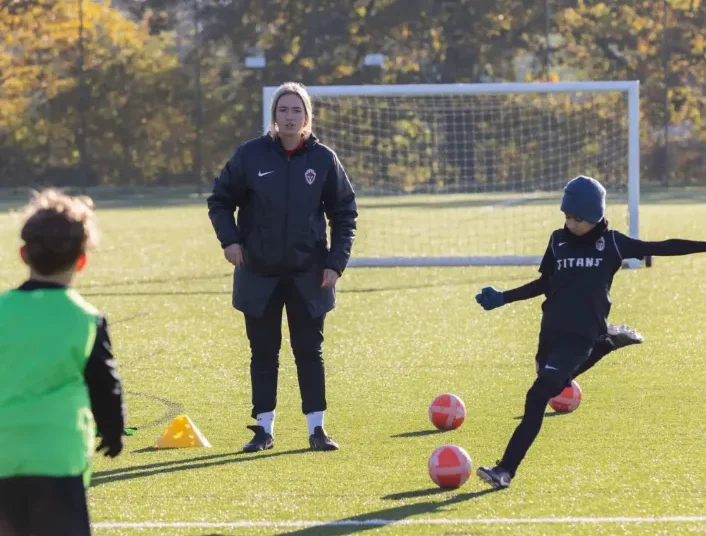Youth soccer is an exciting and fast-paced sport that challenges players to master various positions and become valuable contributors to their teams. Understanding the responsibilities of each position and practicing the right drills are crucial steps in helping young players unlock their potential and excel on the field.
Whether you’re a coach guiding your team or a parent looking to help your child improve, focusing on position-specific skills is the key to success. Let’s break down the roles in soccer and explore essential drills that will help players refine their abilities and make a significant impact during matches.
The Goalkeeper: Defending the Net
The goalkeeper is arguably the most critical position on the field. A great goalkeeper is the last line of defense and often determines the outcome of a game. To be successful, young goalkeepers must work on reflexes, positioning, and shot-stopping techniques. Drills that focus on diving, commanding the defense, and quick reactions are essential for developing solid goalkeeping skills.
Defenders: Protecting the Goal
Defenders play a vital role in stopping the opposing team’s advances and ensuring that the ball doesn’t reach the goal. Whether they’re center-backs, full-backs, or wing-backs, defenders need to have excellent tackling skills, awareness of positioning, and the ability to read the game. Drills like one-on-one defending, marking, and interception practices help strengthen these essential abilities.
Midfielders: Controlling the Game
Midfielders are the heartbeat of the team, linking defense with attack and driving the flow of the game. They need to be versatile, with strong passing, dribbling, and vision. Drills focused on passing accuracy, quick decision-making, and ball control will help young midfielders become effective playmakers.
Explosiveness is particularly valuable for midfielders. Quick changes of direction, sudden sprints, and rapid acceleration help players win duels, break defensive lines, and transition from defense to attack swiftly. Improving explosiveness through specific training enhances their ability to dominate the midfield and support both offensive and defensive plays.
Forwards: The Goal Scorers
Forwards are tasked with creating and converting goal-scoring opportunities. They need speed, agility, and precise shooting skills. Drills that focus on finishing techniques, off-the-ball movement, and sharp shooting will help young forwards develop into dangerous players in front of goal.
First-step quickness is crucial for forwards. It gives them an edge over defenders, allowing them to sprint past markers and get into scoring positions. By working on their speed and agility, forwards can create more opportunities and make game-changing runs.
Specialized Roles: Mastering Tactical Positions
In addition to the primary positions, soccer features specialized roles that require unique skills and tactical awareness. Let’s explore a few of these positions and the drills that can help players excel.
Center Back or Sweeper: The Defensive Leaders
The center-back is the anchor of the defense, responsible for stopping attacks and clearing the ball. Sweepers play a slightly more advanced role, positioning themselves behind the center-backs and acting as a last line of defense. Drills that improve tactical awareness, passing out of defense, and decision-making are key to mastering these positions.
Wing-Backs: The Dual Threats
Wing-backs play a versatile role, contributing both defensively and offensively. They need stamina, crossing skills, and the ability to track back and defend wide areas. Drills focusing on crossing accuracy, one-on-one defending, and overlapping runs will help wing-backs become effective on both ends of the pitch.
Holding Midfielder: The Defensive Shield
Holding midfielders act as the shield for the defense, breaking up opposing attacks and distributing the ball to teammates. They need strong tackling skills, excellent passing ability, and great vision. Drills that focus on shielding the ball, intercepting passes, and recycling possession are essential for developing a strong holding midfielder.
Attacking Midfielder: The Playmaker
Attacking midfielders are responsible for creating goal-scoring chances. They need to be able to read the game, make decisive passes, and take on defenders. Drills that enhance vision, passing, and dribbling in tight spaces will help attacking midfielders become more effective in the final third.
Conclusion
Understanding and mastering the specific roles in youth soccer is crucial for players looking to improve their game. Whether you’re focused on being a commanding goalkeeper, a creative midfielder, or a lethal forward, honing the skills for each position will make you a more complete player. Through consistent practice, position-specific drills, and developing tactical awareness, young athletes can reach their full potential and help their teams achieve success.
By investing time in these targeted drills and embracing the responsibilities of each position, players can not only excel individually but also contribute meaningfully to their team’s overall performance. The journey to mastering soccer starts with understanding the fundamentals, and from there, the possibilities are endless.
















